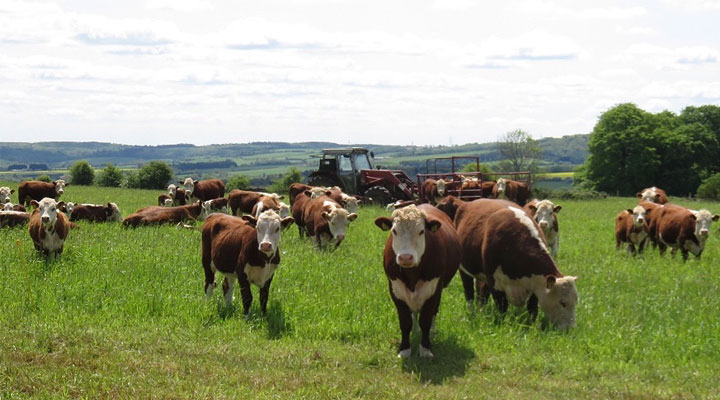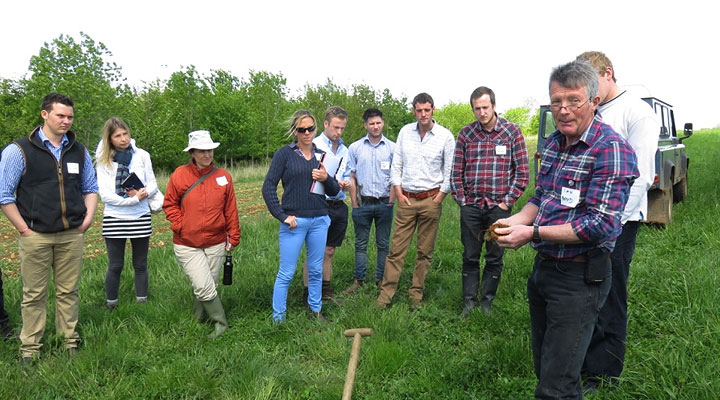Pasture for Life – Case Study – Ian Boyd, Gloucestershire

Trained as a production farmer, it took Ian Boyd 25 years to realise the thin brash soils of the Cotswold Hills where he farms, were holding him back from making a good farming business.
So he changed his ways, fully embracing Higher Level Stewardship (HLS), allowing him to turn the farm’s unproductiveness into a strength.
Out of a total of 280ha, 110ha is now organic grassland, with 45ha of permanent pasture – some of which has SSSI status, and 65ha of HLS recreated Species-Rich Calcareous Grassland.
“This move came with strict restrictions,” says Ian. “We had to graze it with native breed cattle at a low stocking rate of 0.4 LU/ha, hay could be made from it but not before 15 July, and no productive grasses could be sown. So we bought a small herd of pedigree polled Hereford cows in 2007 and operate a closed suckler herd. All the calves are fattened here or retained for breeding.”
The herd of 20 cows and their progeny rotationally graze three areas of grassland every three to four weeks.
Bulls are kept in outlying fields, except for when they are needed to serve the cows – from 1 July, so that calving starts from 7 April the following year. The cows are expected to produce between eight and ten pregnancies and are only culled when they are not in calf. The eldest cow is now 14 years of age.
The main herd outwinters on deferred grazing and some of the late-cut hay is placed in ring feeders. Ian makes 80 to 100 tonnes of round bales each year, which is usually more than is required. It is stored in a Dutch barn and empty cattle sheds until it is needed.
The fattening cattle are never weighed, but reach 650kg or more by the time they are slaughtered at between 27 and 39 months of age. There is very little weight gain in winter, but massive compensatory growth in spring and summer off grazed grass.
Ian currently finishes 12 animals a year at conformation O+ and fat levels of 4L to 5H. They are marketed direct to consumers via meat boxes, sold mainly via the Internet and repeat orders.
“We never anticipated that the cattle enterprise would make a profit,” says Ian. “But the surprise is that it does!
“The grazing and hay fields are essentially free, as the HLS payments are designed to pay for the land’s profit foregone. The cattle are there purely to manage the pasture as a bio-diverse habitat.
“The system has been designed around how I imagine cattle would have been kept 100 years ago, very simple, with minimal labour input. Most days I would only expect to walk or drive around the herd before breakfast.”
Variable costs are also kept very low – with no fertiliser, wormers, silage plastic or concentrate feeds costs, and minimal housing, straw and muck costs. Copper boluses are given, as there are deficiencies in the soil and there have been problems in the past.
“We realise that our finished cattle do not meet the rigid modern meat trade requirements – they are often older and fatter and would attract price penalties. Yet the taste and flavour of our beef gives it a unique selling point. The meat trade seems to put no value on these really important attributes, and we consider this is a gap in the market that the supermarkets cannot fill.”

All the beef is dry aged for a minimum of 28 days to remove some of the moisture – which gives the meat great flavour and it does not shrink as it is cooked.
The Boyds sell it mainly in boxes – either as a Mixed Box, a Winter Warmer Box or a Taster Box. These are posted nationwide in recycled cardboard with sheep’s wool insulation and water-filled ice sheets to keep the meat at the right temperature during transport.
“In essence we were selling pasture-fed meat before the Pasture-Fed Livestock Association even existed,” says Ian. “Our consumers are really interested in the ‘Pasture for Life’ principle and it is refreshing to re-connect with the people who buy and eat our meat.
“It also gives my business an essential competitive advantage over my neighbours and other conventional meat producers. Finally it gives me great pride in my produce – I know I am selling the very best quality meat anyone can buy.”



